Physical Address
304 North Cardinal St.
Dorchester Center, MA 02124
Pigmentation refers to pigment formation in tissues. Abnormal accumulation or decreased / absent pigment causes skin pigmentation disorders that present as hyperchromic (hyperpigmentation) or hypochromic / achromic (leukoderma) lesions, respectively. The disorders may be caused by genetic, metabolic, endocrine, nutritional, neoplastic, chemical, physical, inflammatory, allergic, and infectious factors.
Hyperpigmentation may be endogenous or exogenous according to the origin of the pigment. It may also be congenital / hereditary or acquired.
Melanin is a pigment produced by the melanocytes, within the melanosomes, in a reaction catalyzed by tyrosinase during the conversion of tyrosine into dopa. Melanin is transferred to the keratinocytes and phagocytosed by macrophages (melanophages) provided it reaches the dermis. There are two types of melanin: feomelanin, which is yellow to red, and eumelanin, which is brown to black. The latter is responsible for skin pigmentation and photoprotection.
Melanin is demonstrated by Fontana–Masson staining and dopa reaction.
Table 35-1 describes the congenital and / or hereditary focal melanocytic lesions.
| Type | Onset | Clinical Aspects | Most Frequent Sites | Associations | Pathologic Findings | Malignization |
|---|---|---|---|---|---|---|
| Lentigo simplex | Birth Childhood Puberty |
A regular brown or black macula less than 5 mm long, well defined borders, increases with age | Any part of the body | Peutz–Jeghers syndrome, Leopard syndrome, Carney Complex, LAMB syndrome, NAME syndrome | Mild acanthosis, regular stretching of the epithelial crests, increased number of melanocytes, hyperpigmentation of the basal layer | No |
| Ephelid | Childhood Puberty |
Light or dark brown macula, 2–5 mm, poorly defined borders Becomes darker during summer |
Areas exposed to sunlight (face and shoulders) | Normal epidermis, normal number of melanocytes, which are larger and more active | No | |
| Cafe-au-lait spot | Birth Childhood |
Round or oval macula, larger than 5 mm, regular light brown pigmentation, well-defined borders | Trunk or limbs | Neurofibromatosis, Albright syndrome | Increased melanin content in all layers of the epidermis | No |
| Congenital melanocytic nevus | Birth | Small (less than 1.5 cm), medium (1.5–19.9 cm), giant (larger than 20 cm) Dark brown to black plaque, well-defined borders, hypertrichosis, satellitosis |
Lumbar region | Neurocutaneous melanosis | Individualized nevic cells among collagen fibers in the reticular dermis and subcutaneous tissue | Yes (giant nevi) |
| Nevus spilus | Birth Childhood |
Cafe-au-lait spot dotted with punctiform darker hyperpigmentation | Trunk or limbs | Macula: lentiginous epidermal hyperplasia, hyperpigmentation of the basal layer, increased number of melanocytes, punctiform elements: junctional or compound nevi | Rare | |
| Becker nevus | Puberty | Light or dark brown plaque, 10–20 cm, hair on the surface, rapid growth and then becomes stable. More frequent in men | Shoulder, submammary or scapular regions | Hypoplasia of ipsilateral breast, areola, nipple and arm | Acanthosis, stretching of the epidermal crests, hyperpigmentation of the basal layer, normal or slightly increased number of melanocytes, increase in the number of hair follicles | No |
| Nevus of Ota | Birth Childhood Puberty |
Blue-grayish macula, well-defined irregular borders Usually unilateral | Eyes, eyelids and face; nasal, labial and palate mucosae | Changes in the eye, neurocutanoeous melanoblastosis | Normal epidermis Intradermal dendritic melanocytic nevus |
Rare |
| Nevus of Ito | Birth Childhood Puberty |
Blue-grayish macula, well-defined and irregular borders | Scapular, supraclavicular, and deltoidean regions | Normal epidermis Intradermal dendritic melanocytic nevus |
No | |
| Common blue nevus | Childhood | Blue or black macula, isolated, less than 1 cm, well-defined regular borders | Hands and feet | Normal epidermis Proliferation of dendritic melanocytes in the dermis |
Rare | |
| Cellular blue nevus | Puberty Adulthood (women) |
Bluish papule, 1–3 cm, firm | Buttocks and sacrococcigeal region | Normal epidermis Proliferation of dendritic melanocytes, spindle cells in the dermis |
Rare | |
| Ash-leaf spots | Birth Childhood |
Hypochromic macula, 0.5–12 cm, resembling a leaf | Trunk | Tuberous sclerosis complex | Normal number of melanocytes, but melanocyte activity is down regulated | No |
| Achromic nevus ( Figure 35-3 ) | Birth Childhood Puberty |
Hypochromic macula, regular or irregular borders It is permanent and does not increase in size |
Usually unilateral, with metameric distribution | Normal number of melanocytes, yet these are hypoactive | No |
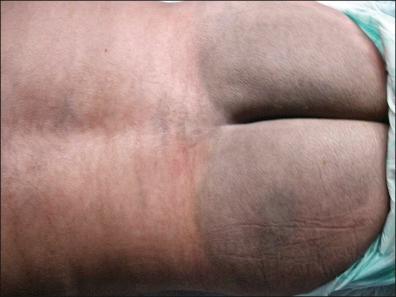
Mongolian spot is more frequently observed in black and Asian individuals. It is a circular or irregular blue-grayish spot, with poorly defined borders; it is localized on the buttocks and lumbosacral regions ( Fig. 35-1 ). It disappears by the age of 2 years. In other regions, areas of generalized, multiple, and deeper pigmentation may persist and be associated with some innate metabolism errors. Other malformations may also be present, including phakomathosis pigmentovascularis. Histologically, dendritic and spindle-shaped melanocytes are scattered deep in the dermis.
This is a rare X-linked genodermatosis caused by a mutation in the NEMO gene. It affects female neonates and is usually lethal in males. The lesions follow the Blashko lines ( Fig. 35-2 ) and present in four developmental phases: vesicobullous, hyperkeratosis, hyperpigmentation, and hypopigmentation. Extracutaneous manifestations occur in 70–80% of cases. Histology findings depend on the developmental phase: vesicles containing eosinophils; hyperkeratosis, dyskeratosis, acanthosis and papillomatosis; pigmentary incontinence; or atrophy of the epidermis and annexes. Treatment is symptomatic.
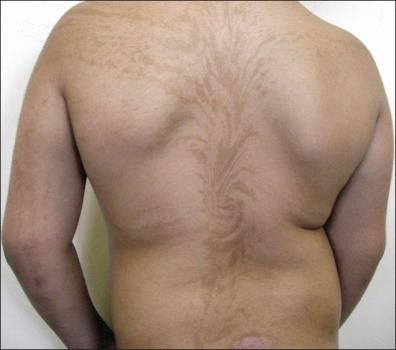
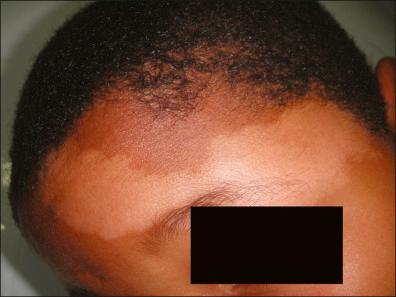
Table 35-2 describes the acquired focal melanocytic changes.
| Type | Onset | Clinical Aspects | Most Frequent Sites | Associations | Pathologic Findings | Malignization |
|---|---|---|---|---|---|---|
| Common acquired melanocytic nevus | Childhood Puberty |
Junctional: flat, homogeneous dark brown or black Compound: light colored papule Intradermal: light-colored papule Increased number of nevi with age, fast growth during puberty, and maximum peak during the third decade of life |
Any part of the body | Nevus cells forming nests or cords Junctional: dermal–epidermal junction Intradermal: dermis Compound: dermal–epidermal junction and dermis |
Rare | |
| Atypical nevus (dysplastic) |
Childhood Puberty |
Lesion 3–15 mm, macular surface in periphery and papule in central surface Asymmetry, poorly defined and irregular borders, several colors There may be erythema within or outside the lesion and hair |
Trunk | Atypical nevus syndrome | Melanocytic hyperplasia and atypical melanocytes Papillary dermis: eosinophilic fibrosis and perivascular lymphocyte infiltrate |
Yes |
| Sutton nevus (halo nevus) | Childhood Puberty Adulthood |
Achromic halo surrounding a nevus that is usually undergoing regression | Trunk | Vitiligo | Lymphocytic inflammatory reaction in a junctional, compound, intradermal, dysplastic nevus and melanoma | Yes |
| Reed nevus (juvenile melanoma) | Childhood Puberty Adulthood (women) |
Uniformly pigmented papule, 2–20 mm, defined regular borders | Lower limbs | Prevalence of spindle cells | Rare | |
| Spitz nevus | Childhood Puberty |
Pink-brownish dome-shaped lesions, 2–20 mm, well-defined regular borders, smooth surface | Face and neck | Nests containing large and round melanocytes (epithelioid) and / or spindle shaped melanocytes Vascular ectasia |
Rare | |
| Solar lentigo | Adulthood > 30 years | Light to dark brown spot, 5–15 mm, well-defined regular or irregular borders | Areas exposed to sunlight, more specifically back of the hands, forearm and face | Other actinic lesions | Epidermal hyperplasia, regular stretching and anastomosis of interpapillary crests, normal or increased number of melanocytes, hyperpigmentation of the basal layer and solar elastosis | No |
| Lentigo maligna | Elderly | Slow growing macula, various shades of brown, irregular borders | Areas exposed to sunlight, especially the face | Other actinic lesions | Proliferation of atypical melanocytes within the atrophic epidermis and actinic degeneration | Yes (lentigo maligna melanoma) |
| Seborrhoeic keratosis | Adulthood | Slightly raised and light brown lesions Gradually they thicken and take on a rough, warty surface |
Any part of the body | Leser–Trelat syndrome | Epidermal tumor composed of predominantly basaloid cells. Hyperpigmentation of the basal layer Acanthotic, hyperkeratotic, reticular or verrucous forms |
No |
| Melanoma | Adulthood Rare in childhood and puberty |
Flat, pigmented macules, papules or nodules. Rapid growth and metastasis | Legs (women); Back (men); Palm, sole and subungual in Africans and Asians | Proliferation of atypical melanocytes | — |
This condition is frequently reported in dark-skinned women. Hormone, genetic, and racial factors are implied and sunlight exposure worsens the picture. Melasmas are brownish macules, with well-defined and irregular borders, located especially on the frontal, malar, and supralabial regions ( Fig. 35-4 ). Extrafacial manifestations may be present. According to the location of melanin, it may be epidermal (brown / black, intensified under Wood lamp), dermal (bluish), or dermal–epidermal. Treatment requires depigmenting substances: tyrosinase inhibitors (hydroquinone, arbutin, deoxyarbutin, aloesin, flavonoids, mequinol, rucinol, hydroxystilbene derivates, licorice extracts, kojic acid, azelaic acid, vitamin C, ellagic acid, gentisic acid, linoleic acid, dioic acid, cinnamic acid, silymarin), melanin transfer inhibitors (niacinamide, soymilk and soybean extracts, and lectins), or agents that accelerate skin scaling (retinoids, α-hydroxy acids, linoleic acid, salicylic acid, and mandelic acid). Hydroquinone 2–4% is the most efficacious agent. However, there are some concerns regarding its safety. Its efficacy may be increased by the association with tretinoin 0.025–0.1%. Corticosteroids reduce skin irritation. Photoprotection is essential. Topical antioxidants (vitamin C, vitamin E, tranexamic acid, and ferulic acid) help the skin-lightening process. Systemic antioxidants (β-carotene, vitamin C, vitamin E, Polypodium leucotomus extract, grapeseed extract, tranexamic acid, and pycnogenol) enhance the photoprotection. Peelings and laser therapy are used as coadjuvant treatment. The condition improves, but may recur.
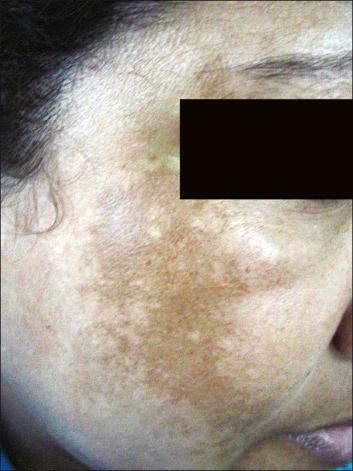
A change in pigmentation is more intense in black skin and is associated with increased levels of melanocyte-stimulating hormone (MSH). Hyperpigmentation becomes more evident on the areolas, axillae, linea alba, genitals and medial aspect of the tights. Melasma is common. Pigmentation of scars and preexisting melanocytic lesions intensifies. Treatment is not necessary because the condition improves after the child is born.
This is a form of primary cutaneous amyloidosis, and its etiopathogenesis remains unclear. Epstein–Barr virus, genetic predisposition, atopy and friction are predisposing factors. It is more common in women between 21 and 50 years of age. The spots are brownish, lace-like, and usually located on the upper back. Histopathology reveals incontinentia pigmenti and amorphous material in the papillary dermis, which shows birefringence when stained by red Congo and under polarized light. Treatment is disappointing and the following may be used: topical corticoids, calcipotriol and dimethylsulfoxide, phototherapy, and Q-switched Nd : YAG laser.
This is an uncommon chronic disease, more common in young dark-skinned women, and it is not clear as yet whether it is a variant of lichen planus or a different entity. The predisposing factors include: pesticide use; contact with radiographic contrast medium; nematode, HIV, or hepatitis C virus infection; and immune, endocrine, or genetic disease. The blue-grayish, oval, or polycyclic maculae are asymptomatic, and present erythematous, initially elevated edges and centrifugal growth. Distribution is symmetric, with a preference for the face, neck, trunk, and proximal portions of the upper limbs. Histology shows vacuolation of the basal layer, colloid bodies, lymphocyte exocytosis, incontinentia pigmenti, and perivascular lymphocytic inflammatory infiltrate. Several treatments have been proposed including photoprotection, depigmentation, topical or systemic corticosteroids, isoniazid, griseofulvin, antimalarial, dapsone, clofazimine, phototherapy, and laser therapy.
This condition is more common in black individuals and occurs after some skin conditions (e.g., lichen planus, acne, drug reactions, phototoxic and photoallergic reactions, mastocytosis, prurigo) or injuries (e.g., trauma, peelings, chronic friction). It is more associated with the nature of the aggression than with the grade of inflammation. Maculae are present in the previous inflammatory sites, and their intensity is directly associated with the phototype ( Figs. 35-5 and 35-6 ). The site of the melanin determines the color: brown (epidermis) or blue-grayish (dermis). Sunlight exposure or persistent inflammation worsens the condition. Histopathology shows increased melanin content in the basal layer, incontinentia pigmenti, and superficial perivascular lymphocytic and hystiocytic infiltrate. The treatment consists of eradicating the underlying skin condition with corticosteroids, tacrolimus, pimecrolimus, or topic depigmentation agents; however, attention should be given to worsening of the picture if irritation occurs. It persists for months and regression is slow in epidermal pigmentation, or remains in the dermis.
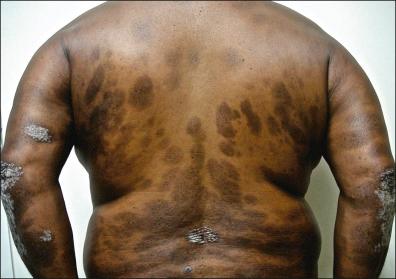
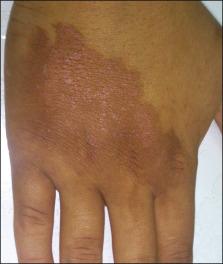
Dark velvet-like spots are observed on the neck, axillae, groins, and periumbilical and inframammary regions ( Fig. 35-7 ). They may indicate an internal disease, and be associated with obesity, diabetes mellitus, polycystic ovary syndrome, Cushing syndrome, or malignancy, especially gastric adenocarcinoma, or with certain medications. Histology reveals hyperkeratosis, hyperpigmentation, and papillomatosis. Improvement is related to resolution of the underlying disease. Treatment may include keratolytic agents, urea, hydroquinone, and retinoic acid. Systemic treatment includes isotretinoin and metformin (hyperandrogenism) and the procedures used are peeling and laser therapy.
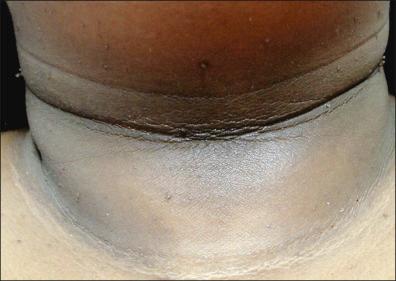
Become a Clinical Tree membership for Full access and enjoy Unlimited articles
If you are a member. Log in here